end
fitvalue(i)=temp;
end
fitvalue=fitvalue';
% 2.4 选择复制
% 选择或复制操作是决定哪些个体可以进入下一代。程序中采
用赌轮盘选择法选择,这种方法较易实现。
% 根据方程 pi=fi/∑fi=fi/fsum ,选择步骤:
% 1) 在第 t 代,由(1)式计算 fsum 和 pi
% 2) 产生 {0,1} 的随机数 rand( .),求 s=rand( .)*fsum
% 3) 求 ∑fi≥s 中最小的 k ,则第 k 个个体被选中
% 4) 进行 N 次 2)、3)操作,得到 N 个个体,成为第 t=t+1
代种群
%遗传算法子程序
%Name: selection.m
%选择复制
function [newpop]=selection(pop,fitvalue)
totalfit=sum(fitvalue); %求适应值之和
fitvalue=fitvalue/totalfit; %单个个体被选择的概率
fitvalue=cumsum(fitvalue); % 如 fitvalue=[1 2 3 4] , 则
cumsum(fitvalue)=[1 3 6 10]
[px,py]=size(pop);
ms=sort(rand(px,1)); %从小到大排列
fitin=1;
newin=1;
while newin<=px
if(ms(newin))
end
% 2.7 求出群体中最大得适应值及其个体
%遗传算法子程序
%Name: best.m
%求出群体中适应值最大的值
function [bestindividual,bestfit]=best(pop,fitvalue)
[px,py]=size(pop);
bestindividual=pop(1,:);
bestfit=fitvalue(1);
for i=2:px
if fitvalue(i)>bestfit
bestindividual=pop(i,:);
bestfit=fitvalue(i);
end
end
% 2.8 主程序
%遗传算法主程序
%Name:genmain05.m
clear
clf
popsize=20; %群体大小
chromlength=10; %字符串长度(个体长度)
pc=0.6; %交叉概率
pm=0.001; %变异概率
pop=initpop(popsize,chromlength); %随机产生初始群体
for i=1:20 %20 为迭代次数
[objvalue]=calobjvalue(pop); %计算目标函数
fitvalue=calfitvalue(objvalue); %计算群体中每个个体的适应度
[newpop]=selection(pop,fitvalue); %复制
[newpop]=crossover(pop,pc); %交叉
[newpop]=mutation(pop,pc); %变异
[bestindividual,bestfit]=best(pop,fitvalue); %求出群体中适应值
最大的个体及其适应值
y(i)=max(bestfit);
n(i)=i;
pop5=bestindividual;
x(i)=decodechrom(pop5,1,chromlength)*10/1023;
pop=newpop;
end
fplot('10*sin(5*x)+7*cos(4*x)',[0 10])
hold on
plot(x,y,'r*')
hold off
[z index]=max(y); %计算最大值及其位置
x5=x(index)%计算最大值对应的 x 值
y=z
【问题】求 f(x)=x 10*sin(5x) 7*cos(4x)的最大值,其中 0<=x<=9
【分析】选择二进制编码,种群中的个体数目为 10,二进制编码
长度为 20,交叉概率为 0.95,变异概率为 0.08
【程序清单】
%编写目标函数
function[sol,eval]=fitness(sol,options)
x=sol(1);
eval=x 10*sin(5*x) 7*cos(4*x);
%把上述函数存储为 fitness.m 文件并放在工作目录下
initPop=initializega(10,[0 9],'fitness');%生成初始种群,大小
为 10
[x endPop,bPop,trace]=ga([0 9],'fitness',[],initPop,[1e-6 1
1],'maxGenTerm',25,'normGeomSelect',...
[0.08],['arithXover'],[2],'nonUnifMutation',[2 25 3]) %25 次
遗传迭代
运算借过为:x =
7.8562 24.8553(当 x 为 7.8562 时,f(x)取最大值 24.8553)
注:遗传算法一般用来取得近似最优解,而不是最优解。
遗传算法实例 2
【问题】在-5<=Xi<=5,i=1,2 区间内,求解
f(x1,x2)=-20*exp(-0.2*sqrt(0.5*(x1.^2
x2.^2)))-exp(0.5*(cos(2*pi*x1) cos(2*pi*x2))) 22.71282 的 最 小
值。
【分析】种群大小 10,最大代数 1000,变异率 0.1,交叉率 0.3
【程序清单】
%源函数的 matlab 代码
function [eval]=f(sol)
numv=size(sol,2);
x=sol(1:numv);
eval=-20*exp(-0.2*sqrt(sum(x.^2)/numv)))-exp(sum(cos(2*pi*x))
/numv) 22.71282;
%适应度函数的 matlab 代码
function [sol,eval]=fitness(sol,options)
numv=size(sol,2)-1;
x=sol(1:numv);
eval=f(x);
eval=-eval;
%遗传算法的 matlab 代码
bounds=ones(2,1)*[-5 5];
[p,endPop,bestSols,trace]=ga(bounds,'fitness')
注:前两个文件存储为 m 文件并放在工作目录下,运行结果为
p =
0.0000 -0.0000 0.0055
�
大家可以直接绘出 f(x)的图形来大概看看 f(x)的最值是多少,
也可是使用优化函数来验证。matlab 命令行执行命令:
fplot('x 10*sin(5*x) 7*cos(4*x)',[0,9])
evalops 是传递给适应度函数的参数,opts 是二进制编码的精度,
termops 是选择 maxGenTerm 结束函数时传递个 maxGenTerm
的参数,即遗传代数。xoverops 是传递给交叉函数的参数。
mutops 是传递给变异函数的参数。
【问题】求 f(x)=x+10*sin(5x)+7*cos(4x)的最大值,其中 0<=x<=9
【分析】选择二进制编码,种群中的个体数目为 10,二进制编码
长度为 20,交叉概率为 0.95,变异概率为 0.08
【程序清单】
%编写目标函数
function[sol,eval]=fitness(sol,options)
x=sol(1);
eval=x+10*sin(5*x)+7*cos(4*x);
%把上述函数存储为 fitness.m 文件并放在工作目录下
initPop=initializega(10,[0 9],'fitness');%生成初始种群,大小
为 10
[x endPop,bPop,trace]=ga([0 9],'fitness',[],initPop,[1e-6 1
1],'maxGenTerm',25,'normGeomSelect',...
[0.08],['arithXover'],[2],'nonUnifMutation',[2 25 3]) %25 次
遗传迭代
运算借过为:x =
7.8562 24.8553(当 x 为 7.8562 时,f(x)取最大值 24.8553)
注:遗传算法一般用来取得近似最优解,而不是最优解。
遗传算法实例 2
【问题】在-5<=Xi<=5,i=1,2 区间内,求解
f(x1,x2)=-20*exp(-0.2*sqrt(0.5*(x1.^2+x2.^2)))-exp(0.5*(cos(2*
pi*x1)+cos(2*pi*x2)))+22.71282 的最小值。
【分析】种群大小 10,最大代数 1000,变异率 0.1,交叉率 0.3
【程序清单】
%源函数的 matlab 代码
function [eval]=f(sol)
numv=size(sol,2);
x=sol(1:numv);
eval=-20*exp(-0.2*sqrt(sum(x.^2)/numv)))-exp(sum(cos(2*pi*x))
/numv)+22.71282;
%适应度函数的 matlab 代码
function [sol,eval]=fitness(sol,options)
numv=size(sol,2)-1;
x=sol(1:numv);
eval=f(x);
eval=-eval;
%遗传算法的 matlab 代码
bounds=ones(2,1)*[-5 5];
[p,endPop,bestSols,trace]=ga(bounds,'fitness')
注:前两个文件存储为 m 文件并放在工作目录下,运行结果为
p =
0.0000 -0.0000 0.0055
大家可以直接绘出 f(x)的图形来大概看看 f(x)的最值是多少,
也可是使用优化函数来验证。matlab 命令行执行命令:
fplot('x+10*sin(5*x)+7*cos(4*x)',[0,9])
evalops 是传递给适应度函数的参数,opts 是二进制编码的精度,
termops 是选择 maxGenTerm 结束函数时传递个 maxGenTerm
的参数,即遗传代数。xoverops 是传递给交叉函数的参数。
mutops 是传递给变异函数的参数。
参考资料:不记得了,抱歉
function Main()
%定义全局变量
global VariableNum POPSIZE MaxGens
PXOVER PMutation
VariableNum=3 %变量个数
POPSIZE=50 %种群大小
MaxGens=1000 %种群代数
PXOVER=0.8 %交叉概率
PMutation=0.2 %变异概率
%读取数据文件
load E:\现代优化算法\遗传算法\bound.txt
VarBound=bound(:,1:2);
global Pop newPop
Pop=zeros(POPSIZE+1,VariableNum);
newPop=zeros(POPSIZE+1,VariableNum);
%初始化种群
for i=1:POPSIZE
for j=1:VariableNum
Pop(i,j)=VarBound(j,1)+rand()*(VarBound(j,2)-VarBound(j,
1));
end
end
%计算适应值
fitnessList=zeros(POPSIZE,1);
for i=1:POPSIZE
fitnessList(i,1)=fitness(Pop(i,1:VariableNum));
end
%保存最好值和最坏值
Best=zeros(1,VariableNum+1);
Worst=zeros(1,VariableNum+1);
maxvalue=max(fitnessList);
indexMax=find(fitnessList==maxvalue,1,'first');
�
Best(1,1:VariableNum)=Pop(indexMax,1:VariableNum);
Best(1,VariableNum+1)=maxvalue;
minvalue=min(fitnessList);
indexMin=find(fitnessList==minvalue,1,'first');
Worst(1,1:VariableNum)=Pop(indexMin,1:VariableNum);
Worst(1,VariableNum+1)=minvalue;
genetation=1;
while genetation1
if VariableNUM==2
point=1;
else
point=round(rand()*(VariableNUM-2)+1);
end
tempOne=zeros(1,point);
tempOne(1,1:point)=Pop(first_index,1:point);
Pop(first_index,1:point)=Pop(second_index,1:point);
Pop(second_index,1:point)=tempOne(1,1:point);
end
end
end
newPop=zeros(size(Pop),1);
newPop=Pop;
�
===============================================
=====
其可能的路径数目
与城市数目 n 是成指数型增长的,所以一般很难精确地求出其最
优解,本文采用遗传算法
%变异操作
求其近似解。
function
newPop=Mutation(Pop,VariableNUM,MutationRate,bound)
point=1;
sizePop=length(Pop);
for i=1:sizePop
for j=1:VariableNUM
Mrate=rand();
if Mrate
按均匀变异(该变异点 xk 的取值范围为[ukmin,ukmax],产生
一个[0,1]中随机数 r,该点
变异为 x'k=ukmin+r(ukmax-ukmin))操作。如:
8 14 2 13 8 6 3 2 5 7 3 4 3 2 4 2 2 1
变异后:
8 14 2 13 10 6 3 2 2 7 3 4 5 2 4 1 2 1
反 grefenstette 编码:交叉和变异都是在 grefenstette
编码之后进行的,为了循环操作
和返回最终结果,必须逆 grefenstette 编码过程,将编码恢
复到自然编码。
循环操作:判断是否满足设定的带数 xzome,否,则跳入适应度
f 的计算;是,结束遗传
操作,跳出。
matlab 代码
distTSP.txt
0 6 18 4 8
7 0 17 3 7
4 4 0 4 5
20 19 24 0 22
8 8 16 6 0
%GATSP.m
function gatsp1()
clear;
load distTSP.txt;
distance=distTSP;
N=5;
ngen=100;
ngpool=10;
%ngen=input('# of generations to evolve = ');
%ngpool=input('# of chromosoms in the gene pool
= '); % size of genepool
gpool=zeros(ngpool,N+1); % gene pool
for i=1:ngpool, % intialize gene pool
gpool(i,:)=[1 randomize([2:N]')' 1];
for j=1:i-1
while gpool(i,:)==gpool(j,:)
gpool(i,:)=[1 randomize([2:N]')' 1];
end
end
end
costmin=100000;
tourmin=zeros(1,N);
cost=zeros(1,ngpool);
increase=1;resultincrease=1;
for i=1:ngpool,
cost(i)=sum(diag(distance(gpool(i,:)',rshift(g
pool(i,:))')));
end
% record current best solution
[costmin,idx]=min(cost);
tourmin=gpool(idx,:);
disp([num2str(increase) 'minmum trip length = '
num2str(costmin)])
costminold2=200000;costminold1=150000;resultco
st=100000;
tourminold2=zeros(1,N);
tourminold1=zeros(1,N);
resulttour=zeros(1,N);
while
(abs(costminold2-costminold1) ;100)&(abs(costmi
nold1-costmin) ;100)&(increase ;500)
costminold2=costminold1;
tourminold2=tourminold1;
costminold1=costmin;tourminold1=tourmin;
increase=increase+1;
if resultcost>costmin
resultcost=costmin;
resulttour=tourmin;
resultincrease=increase-1;
end
for i=1:ngpool,
cost(i)=sum(diag(distance(gpool(i,:)',rshift(g
pool(i,:))')));
end
% record current best solution
[costmin,idx]=min(cost);
tourmin=gpool(idx,:);
%==============
% copy gens in th gpool according to the probility
ratio
% >1.1 copy twice
% >=0.9 copy once
% ;0.9 remove
[csort,ridx]=sort(cost);
% sort from small to big.
csum=sum(csort);
caverage=csum/ngpool;
cprobilities=caverage./csort;
copynumbers=0;removenumbers=0;
for i=1:ngpool,
if cprobilities(i) >1.1
copynumbers=copynumbers+1;
end
�
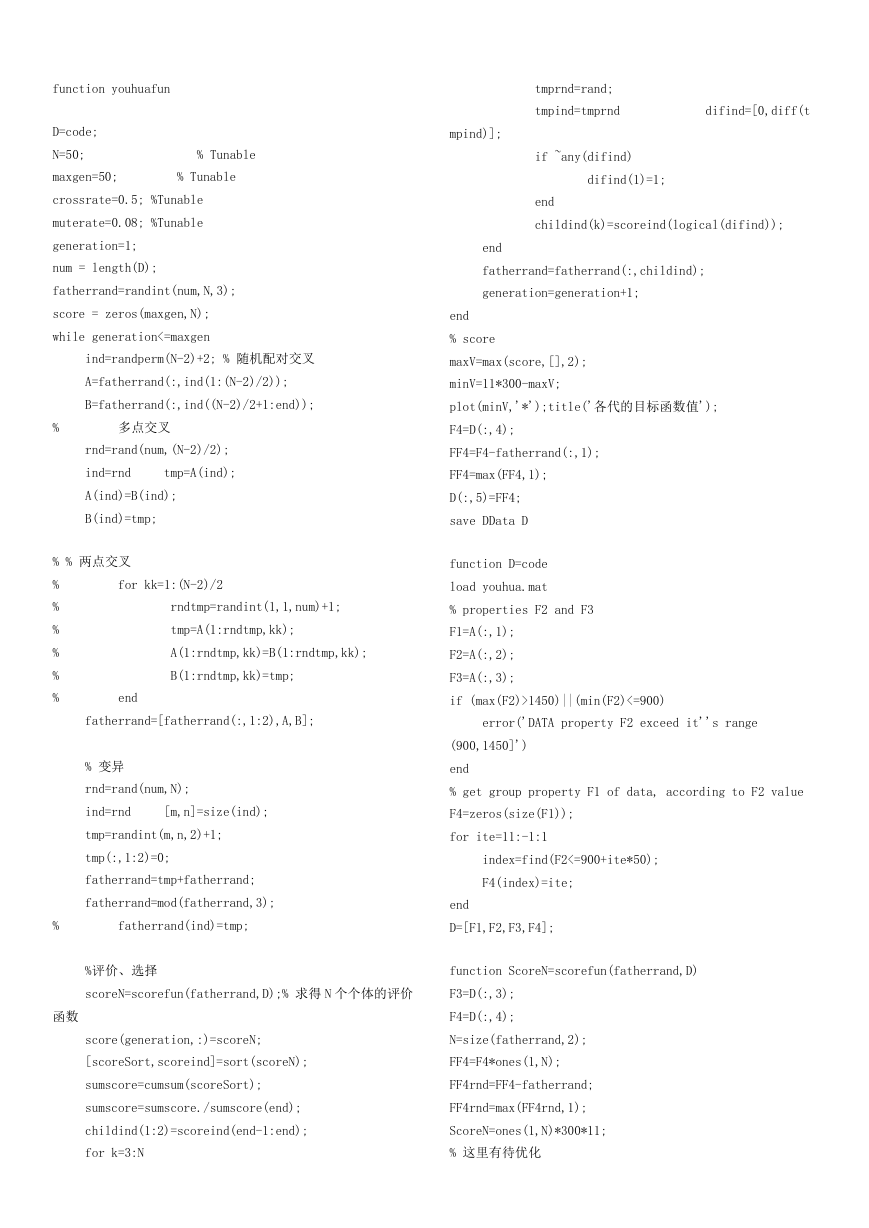


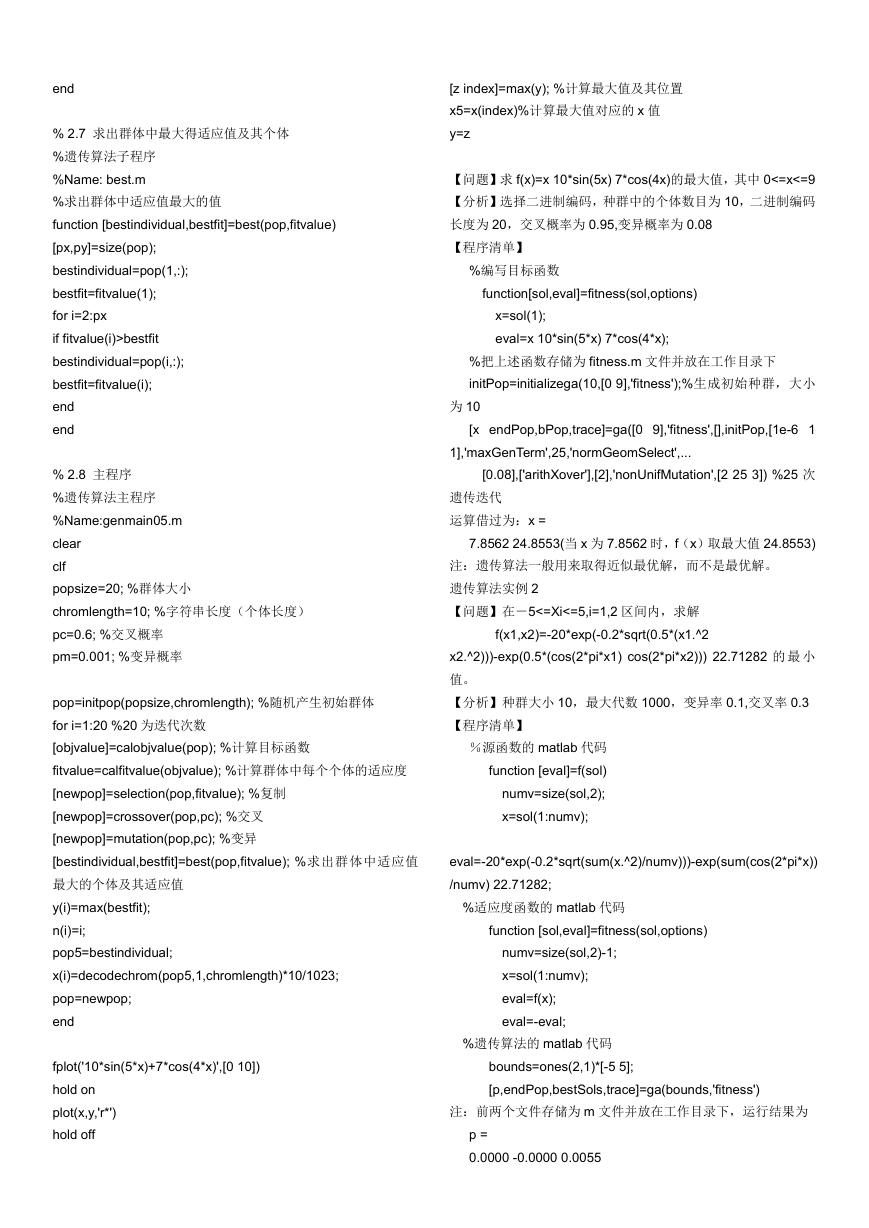
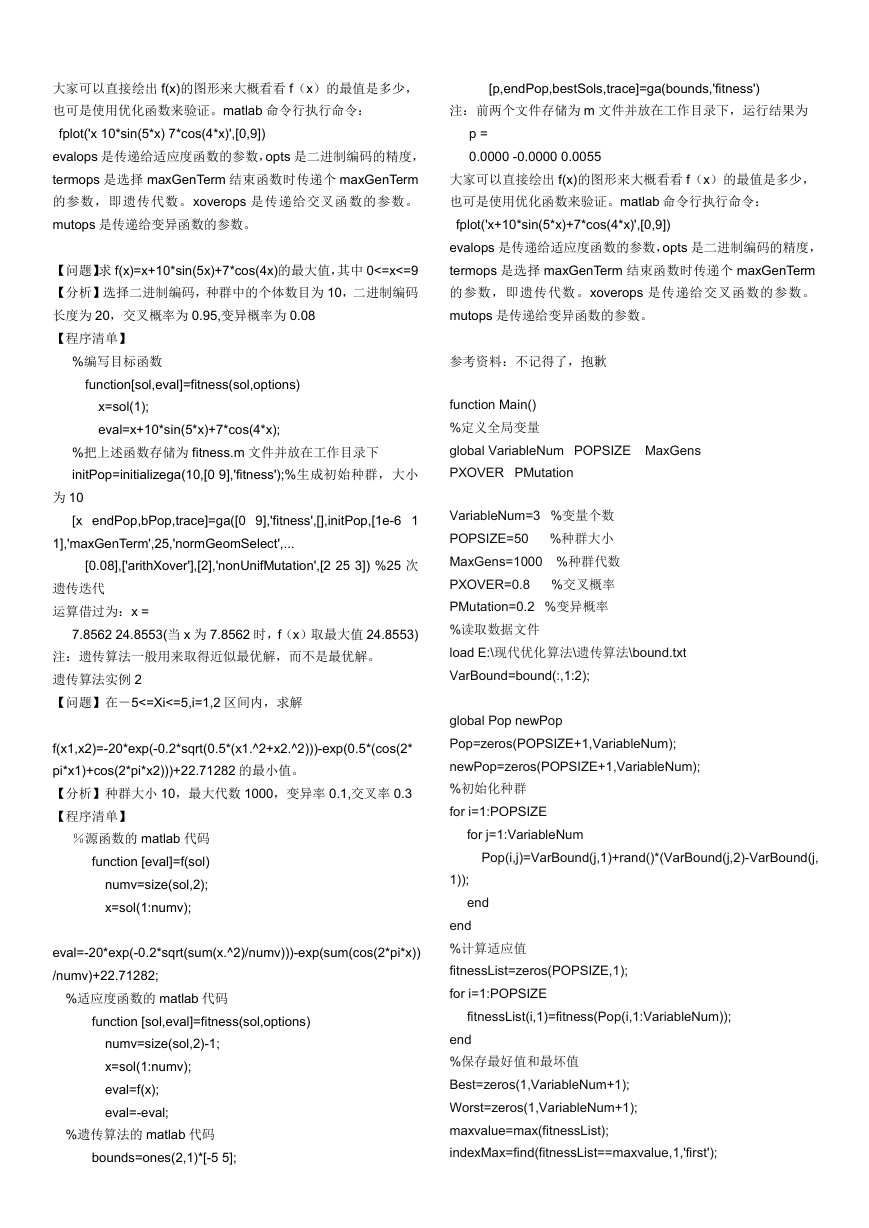
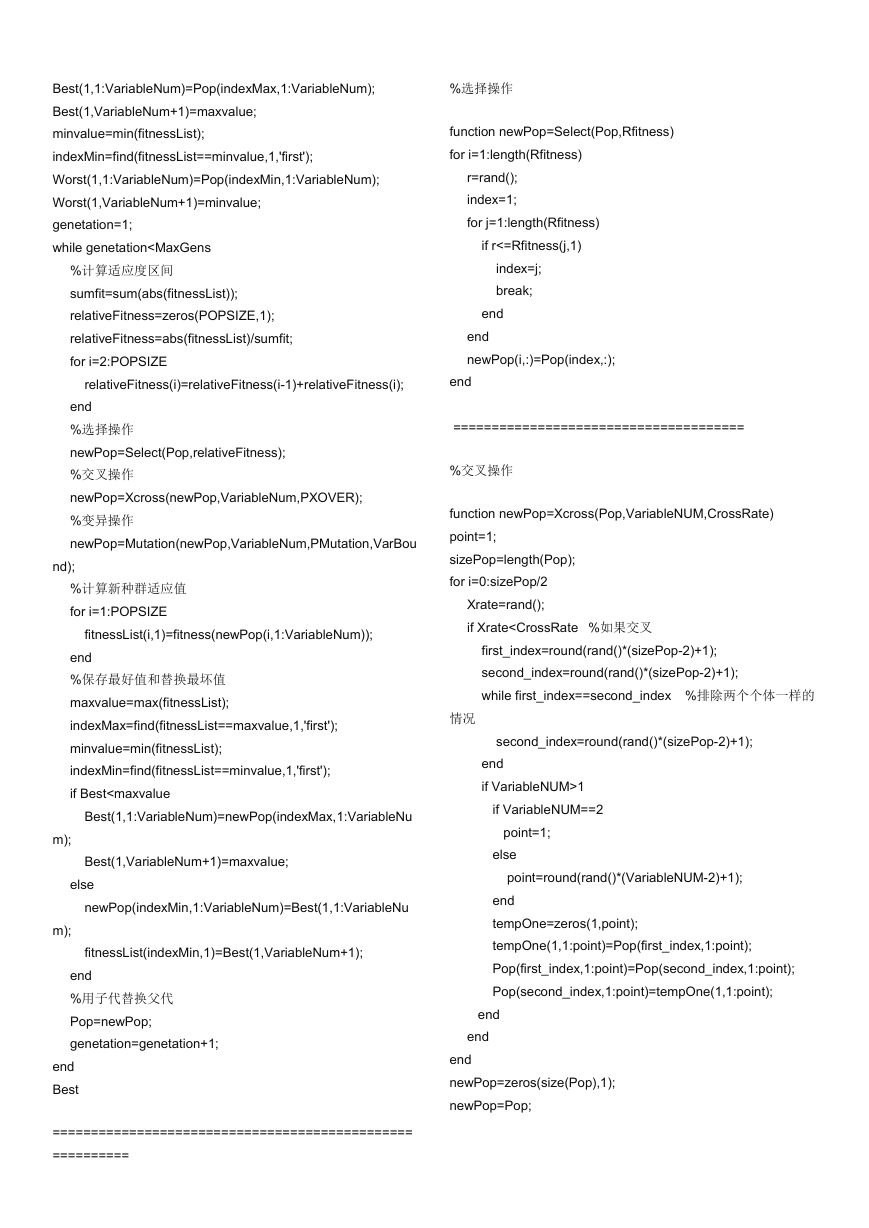
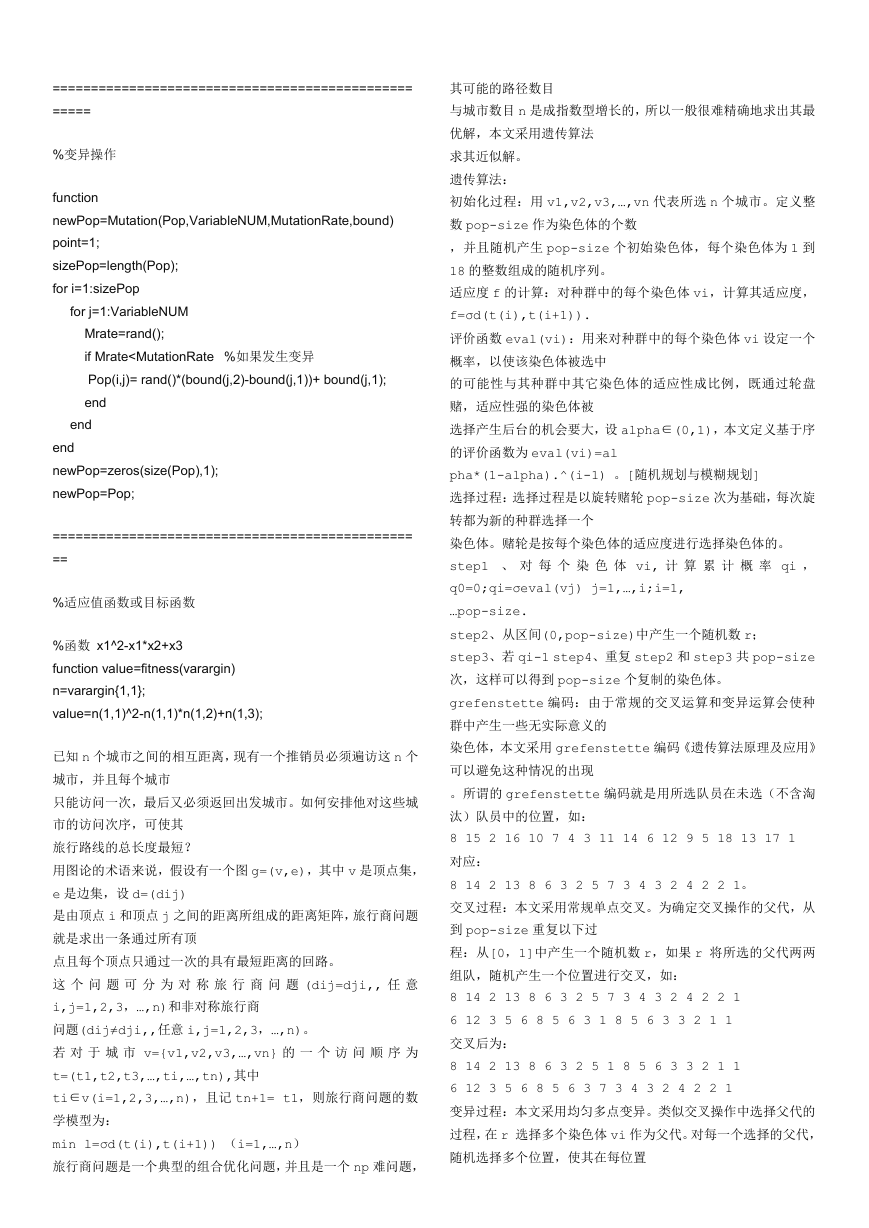









 2023年江西萍乡中考道德与法治真题及答案.doc
2023年江西萍乡中考道德与法治真题及答案.doc 2012年重庆南川中考生物真题及答案.doc
2012年重庆南川中考生物真题及答案.doc 2013年江西师范大学地理学综合及文艺理论基础考研真题.doc
2013年江西师范大学地理学综合及文艺理论基础考研真题.doc 2020年四川甘孜小升初语文真题及答案I卷.doc
2020年四川甘孜小升初语文真题及答案I卷.doc 2020年注册岩土工程师专业基础考试真题及答案.doc
2020年注册岩土工程师专业基础考试真题及答案.doc 2023-2024学年福建省厦门市九年级上学期数学月考试题及答案.doc
2023-2024学年福建省厦门市九年级上学期数学月考试题及答案.doc 2021-2022学年辽宁省沈阳市大东区九年级上学期语文期末试题及答案.doc
2021-2022学年辽宁省沈阳市大东区九年级上学期语文期末试题及答案.doc 2022-2023学年北京东城区初三第一学期物理期末试卷及答案.doc
2022-2023学年北京东城区初三第一学期物理期末试卷及答案.doc 2018上半年江西教师资格初中地理学科知识与教学能力真题及答案.doc
2018上半年江西教师资格初中地理学科知识与教学能力真题及答案.doc 2012年河北国家公务员申论考试真题及答案-省级.doc
2012年河北国家公务员申论考试真题及答案-省级.doc 2020-2021学年江苏省扬州市江都区邵樊片九年级上学期数学第一次质量检测试题及答案.doc
2020-2021学年江苏省扬州市江都区邵樊片九年级上学期数学第一次质量检测试题及答案.doc 2022下半年黑龙江教师资格证中学综合素质真题及答案.doc
2022下半年黑龙江教师资格证中学综合素质真题及答案.doc